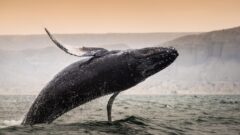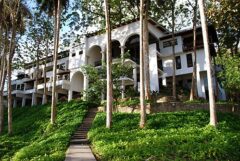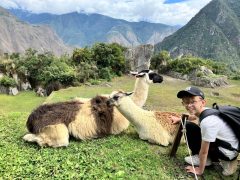The really wild show

How strange it seems not to be breakfasting with a blue-footed booby or going shopping with a sea lion. The surprise of the Galápagos Islands is on the return to the ‘real’ world.
For an enchanted week, my twelve-year-old son, Joseph, and I had been granted entry to an equatorial Eden. We both adored it. We’d got used to it. As for the animals, they seemed to view us with bemused indifference. And that’s the magical part. Why do birds suddenly appear every time you draw near? Because you are on a volcanic island six hundred miles off the coast of South America where birds (and just about everything else) have no fear of man.
We swam with turtles and picnicked with iguanas. It seemed like a dream - but these wonderful creatures cheerfully let us share their world of ocean, forest and boundless sky without flinching from our clumsy presence.
Darwin famously came here as a young man on the survey ship H.M.S. Beagle to study the geology of the islands - which as everyone knows are the tops of volcanoes sticking out of the ocean. They are a mere four million years old. Some are still hot from recent eruptions and blankets of solidified lava flow black over dazzling white sand. But Mr. Darwin soon realised that the inhabitants were more interesting than the rocks. How did they get here? The archipelago was never connected to the mainland. They must have appeared on the islands after the volcanoes emerged from the sea - and then quietly got on with a bit of evolving.
Our version of the Beagle was a fabulous yacht, La Pinta, crewed by charming Ecuadorians, nationals of the country of which the Galápagos Islands are a province.
This is a national park, entry to which is tightly restricted, and private ownership of property within it is prohibited. It was established fifty years ago and represents almost all of the land area of the islands. The remaining three per cent remains open for private ownership and development (there are nearly 30,000 settlers here, visitors are often surprised to learn).
There are farms growing coffee and bananas; there are roads and tin-roofed schools. At the little village of El Progreso, the oldest surviving settlement in the islands (a former penal colony), the Escuela Carlos Darwin has a jolly painted bust of the great man in the schoolyard. He looks like Father Christmas.
In 1986 the Galápagos Marine Resources Reserve was added to the park - within which fishing and tourist boats were restricted and cruise liners forbidden. A good thing too - until you realise that 138,000 visitors fly into Baltra Island’s airstrip from the mainland every year. And settlers are jostling to get in and share the tourist dollar bonanza. How can this unearthly paradise cope?
It seemed to be doing so quite nicely thank you. We were highly privileged aboard La Pinta, which moved at night from island to island - delivering us each morning at some fabulous new beach to be accessed by rubber boats called ‘pangas’.
La Pinta is a downsized cruise liner, optimised for the islands with wetsuits and hot showers for that post-snorkel warm-up. After an encounter with a turtle I was greeted on deck with a mug of Ecuadorian hot chocolate. Everything about La Pinta is luxurious yet businesslike, The Beagle with broadband (and a cocktail bar). The islands, however, are not for pleasure seekers. Nor for backpackers or beach bums. There are cheaper hotels in the major settlements of Puerto Ayora on Santa Cruz island and Puerto Baquerizo Moreno on San Cristóbal - but the high price of physically getting here plus a $100 USD entry fee to the park is designed to keep the idly curious out. The Galápagos Islands demand close attention and deserve it. Everything is in the tiny detail.
And you must obey the rules. Don’t touch the animals. Take nothing back with you but photographs. Stay on the paths (there’s a volcano down there) and don’t go where it says animals only. We learned lots from our professional guides, who are obliged by law to pass examinations every few years to make sure that they know the rules of the national park as well as the names and ecological relationships of the local fauna. They love them, that is clear from the start, but without the Disneyfied sentimentality that outsiders like us bring with them. For example on one beach picking our way across a harem of snoozing female fur seals, Joe suddenly called out ‘Dad! There’s one being born!’ And there was a blob of fur and blood - but immediately frigate birds were pouncing on the placenta and pelicans barging into the feast. It looked utterly horrific until the mother plucked the pup in her mouth and installed it snugly under her tummy. Everyone loves a happy ending.
These animal encounters never failed to astonish. And not just in the wild. Sea lions bask at bus stops. Iguanas prowl the dry stone walls. The Puerto Ayora fish dock was taken over by sea lions and pelicans, leaving the fishmonger under the illusion that he was in charge.
Evenings were spent in philosophic discourse on our place in the cosmos. There are so many puzzles here that it is impossible not to share one’s sense of wonder with anyone who will listen. And there’s nothing like an encounter with a herd of giant tortoises to revive the spirits. We found them on a coffee ranch in the Santa Cruz highlands. The outsize chelonians (you’ve got to pick up on the zoological terms fast) are normally solitary but they come here to cool down together in giant-tortoise-sized mudbaths. Approach them frontally and they retreat into their shell, exhaling air in a resigned sounding sigh. We left them happily munching on overripe guavas, an introduced plant species but nevertheless one they seem especially to adore.
Ecuador has Amazonian jungle and snow-capped mountains. It has a rich indian culture and palmy beaches - but it’s those fantastic islands which really keep the visitors coming.
Christy Campbell
Tailor-made holidays
Flexible, custom-made holidays to Latin America created to match your exact requirements: our tailor-made itineraries are as unique as the clients for whom they are designed.
Design my tripPapagaio
Your edit for Latin American inspiration
Our exciting range of articles on Latin America explore everything from iconic destinations and lesser-known cultural gems to delicious traditional recipes. You’ll also find exclusive travel tips, first-hand client reviews and the chance to get your personal questions answered by our travel experts.
View Extraordinary Inspiration






































